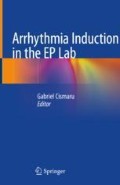Abstract
Catheter ablation has been established as a versatile modality to treat a wide range of tachyarrhythmias. Cost-effectiveness studies have generally favored catheter ablation over medical treatment because of its potential curative effect. In the electrophysiology (EP) laboratory, induction and maintenance of clinical arrhythmias is the cornerstone of diagnosis and treatment, especially in cases where the clinical arrhythmia is not documented on baseline electrocardiogram. Ventricular tachycardia ablation is performed after mapping during sinus rhythm or during tachycardia. Activation mapping during VT is felt to be the most reliable method for the identification of the ablation target but, likewise, requires the VT to be inducible. During VT, a three-dimensional mapping system permits the reconstruction of the reentry circuit, allowing subsequent RF application at the level of reentry isthmus. However, VT induction is not always possible in the basal state. With this, a various number of medications were started to be used as a means to facilitate arrhythmia induction, including isoprenaline, adrenaline, and atropine.
Access this chapter
Tax calculation will be finalised at checkout
Purchases are for personal use only
References
Choi EK, Kumar S, Nagashima K, Lin KY, Barbhaiya CR, Chinitz JS, et al. Better outcome of ablation for sustained outflow-tract ventricular tachycardia when tachycardia is inducible. Europace. 2015;17:1571–9.
Niebauer M, Daoud E, Goyal R, Chan KK, Harvey M, Bogun F, et al. Use of isoproterenol during programmed ventricular stimulation in patients with coronary artery disease and nonsustained ventricular tachycardia. Am Heart J. 1996;131:516–8.
Simonson BG, Stiska J, Strom B. Double-blind trial with increasing doses of salbutamol and terbutaline aerosols in patients with reversible airway obstruction. Acta Med Scand. 1972;192:371–6.
Gray BF, Frame M, Costello JF. A comparative double blind study of the bronchodilator effects and side effects of inhaled fenoterol and terbutaline administered in equipotent doses. Br J Dis Chest. 1982;76:341–50.
Strauss MH, Reeves RA, Smith DL, Leene FHH. The role of cardiac β-1 receptors in the hemodynamic response to beta-2 agonist. Clin Pharmacol Ther. 1986;40:108–15.
Levine MAH, Leenen FHH. Role of beta 1 receptors and vagal tone in cardiac inotropic and chronotropic responses to a beta 2 agonist in humans. Circulation. 1989;79:107–15.
Summers RJ, Molnaar P, Russel F, Elnatan J, Jones CR, Buxton BF, et al. Coexistence and localization of beta 1 and beta 2 adrenoreceptors in the human heart. Eur Heart J. 1989;10:11–21.
Rodefeld MD, Beau SL, Schuessler RB, Boineau JP, Saffitz JE. Beta adrenergic and muscarinic cholinergic receptor densities in the human sinoatrial node. J Cardiovasc Electrophysiol. 1996;7:1039–49.
Crane J, Burgess C, Beasley R. Cardiovascular and hypokalemic effects of inhaled salbutamol, fenoterol, and isoprenaline. Thorax. 1989;44:136–40.
Flatt A, Crane J, Purdie G, Kwong T, Beasley R, Burgess C. The cardiovascular effects of betaadrenergic agonist drugs administered by nebulization. Postgrad Med J. 1990;66:98–101.
Author information
Authors and Affiliations
Corresponding author
Editor information
Editors and Affiliations
Rights and permissions
Copyright information
© 2019 Springer Nature Switzerland AG
About this chapter
Cite this chapter
Cismaru, G. (2019). What to Do When Clinical Arrhythmia Is Uninducible?: Stepwise Approach. In: Cismaru, G. (eds) Arrhythmia Induction in the EP Lab. Springer, Cham. https://doi.org/10.1007/978-3-319-92729-9_22
Download citation
DOI: https://doi.org/10.1007/978-3-319-92729-9_22
Published:
Publisher Name: Springer, Cham
Print ISBN: 978-3-319-92728-2
Online ISBN: 978-3-319-92729-9
eBook Packages: MedicineMedicine (R0)

